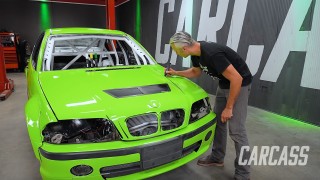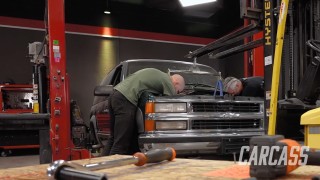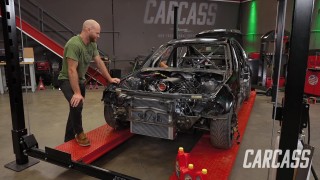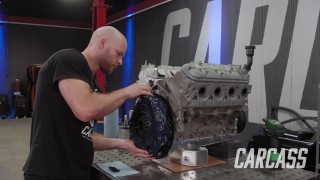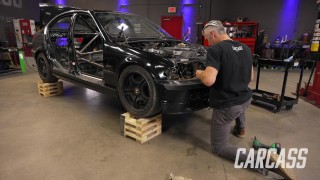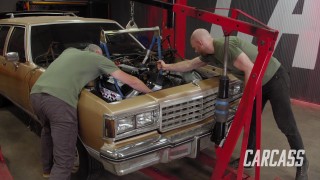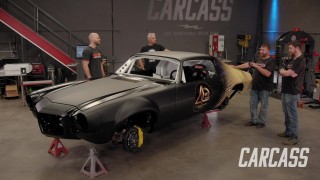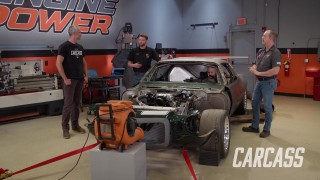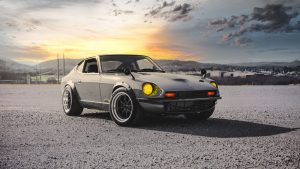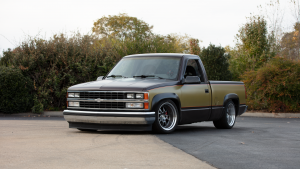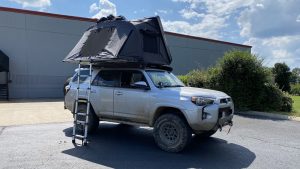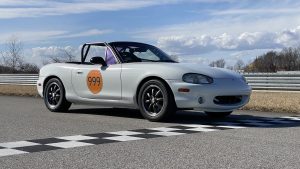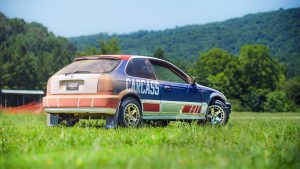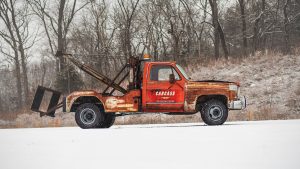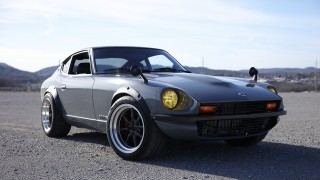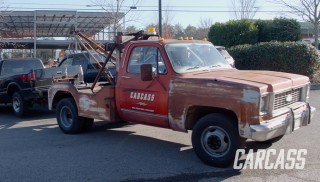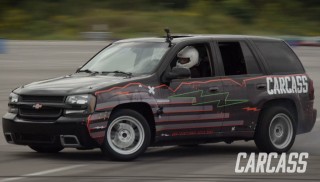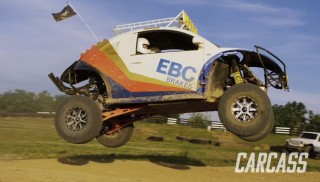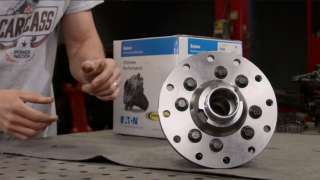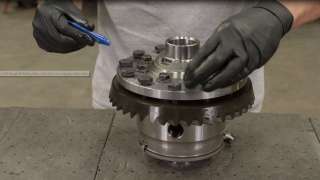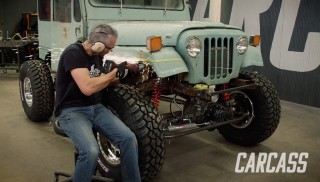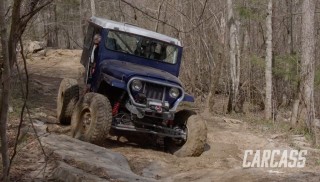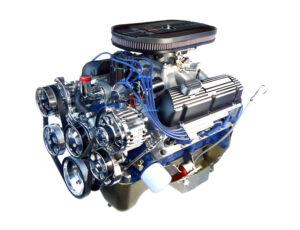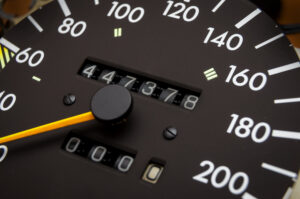Carcass Featured Projects
Carcass Builds
Want more content like this?
Join the PowerNation Email NewsletterParts Used In This Episode
BDS Suspension
BDS Suspension Lift with Nitro Shocks
Matco Tools
MATCO Tools are the Official Tool Supplier to PowerNation
The Industrial Depot
Tools, Hardware, Shop Supplies
Video Transcript
(Jimmy)>> Today on Carcass
we lock the front end of our M1010 military chassis and
give it an 8 inch lift.
(Jeremy)>> Plus we hear our 600 horsepower monster rev to its max on the Engine Power dyno. [ Music ]
(Narrator)>> When you want to build something different you turn to these guys, Jeremy Weckman and Jimmy King. Jeremy was raised in Minnesota building street rods. He's a builder, fabricator, and welder. Jimmy grew up in Nevada working in his dad's garage building cars. He's a mechanical engineer, builder, and fabricator. They take left for dead rides and transform them into one of a kind builds. If you can dream it they can build it. This is Carcass, a non-traditional speed shop.
(Jeremy)>> Introduced by Willys Overland in 1946 it was described as the people's car with its all steel body and ample room for passengers. It advertised easy maintenance, capacity for seven, and had a flat head four cylinder engine.
(Jimmy)>> But that doesn't quite describe our 1953 Willys wagon model. It went through some modifications in the early '50's adding a V-shaped grille, more engine options, and four wheel drive. Our post World War II Willys wagon has taken on a wild new transformation on this Carcass build.
(Jeremy)>> That's right. We took our chassis of our military ambulance, removed the box out back and the cab up front. We sliced it down the middle and we took out about a two foot section.
(Jimmy)>> With the wheel base in the ballpark we were able to drop our Willys body right on top. We fabbed up a handful of body mounts, bolted the two together giving us the first look at this duo.
(Jeremy)>> We're still not done with this project. We've got a small block Chevy with a massive blower that we still need to sit inside this thing, and for the stock mounts well they're just not gonna work. So we had to make some room.
(Jimmy)>> We gutted the interior, unbolted the front end, and got straight to work cutting out that hokey firewall. [ Music ] Dude we've got a list to make.
(Jeremy)>> Oh yeah probably for the stuff we should be doing.
(Jimmy)>> There's a lot of stuff we can do now which will be easier with the body and chassis separated like putting in the lift kit.
(Jeremy)>> Right so if we put the lift kit in we'll have the suspension and the axle out anyways. Let's put the locker in the front.
(Jimmy)>> Good idea, and also with the body the way it is we can also put in the fuel cell.
(Jeremy)>> Oh yeah if we're gonna transition off of that and go inside let's make this thing safer. We'll put a roll cage in it too.
(Jimmy)>> And if we put the roll cage back far enough we can put the radiator in the back too.
(Jeremy)>> Right yeah, so if we put the radiator in the back we can blow all that hot air clean out the back. That's a good idea. Well you wrote down lift kit and locker first. Let's go over there, get the suspension out. We'll work on that locker.
(Jimmy)>> Easy enough!
(Jeremy)>> To free our Dana 60 from the chassis we'll have to unbolt a number of items, including the shocks, the drag link, and the U-bolts that hold everything together.
(Jimmy)>> Then we'll use the lift for raising up the front end of the chassis and freeing the axle. Whoa, oh yeah buddy!
(Jeremy)>> Getting tricky! With the axle and wheel combined weight of a few hundred pounds we'll use the forklift to help get this heavy thing on the stand. Looking good so far. A little bit, done! [ metal clanging ]
(Jimmy)>> With our axle positioned so it's easy to work on we'll remove the wheels and tires. [ drill humming ]
(Jimmy)>> Then we'll remove the hub and rotor assemblies and pull the axle shafts.
(Jeremy)>> We'll unzip the bolts from the diff cover and pop it open. Once the gear oil drains from the case we'll remove the bearing caps... [ Music ] ...and carefully pry this heavy differential from its snug little home.
(Jimmy)>> We'll take the diff over to the work bench and remove all the ring gear bolts. Then we'll tap it with a hammer doing our best not to let it come crashing down and potentially chipping a tooth.
(Jeremy)>> Well now that you're done disassembling the diff let's get on to our Eaton E-locker. [ Music ] The E-locker-4 fits our Dana 60 axle and it's one of the fastest locking differentials out there. Its engagement time is a fraction of a second. Jimmy you know what it's like waiting for a mechanical locker to engage right? Well the convenient thing about this is this is an electronic locker, and a locked front differential, well that's at an arm's reach. It has a four pinion gear design to increase strength and it's available in a variety of spline counts. Now this thing was a no brainer for our front end.
(Jimmy)>> Choosing the right locker can be a little confusing. There's a number of things you need to know before you order one of these guys. First you need to know what kind of axle you're dealing with under your truck. In our case a Dana 60. Second, you need to know your spline count. Our axles have a 35 tooth spline count. And finally you need to know your gear ratio. You can find the gear ratio on a tag bolted down with the cover. If you don't find it there you'll have to crack the cover and get an accurate count of the ring gear teeth and the pinion teeth, and then do a little math. In our Dana 60 we have 4.56 gears.
(Jeremy)>> Knowing we ordered the correct locker, assembly, well that's pretty straight forward. We need to slip the ring gear over the E-locker-4. Add all the bolts making sure to put red thread locker on each one. Then we'll snug them down with an impact in a crisscross pattern. Then use the same pattern to torque them down to 110 foot pounds.
(Jimmy)>> Since we're dealing with an electronic locker we need to drill a hole in the housing for the wiring. These bearing caps are getting a little heavy man. With the correct shim arrangement we can drop in our new differential and tap it into place. Then we'll secure it with bearing caps and check the backlash.
(Jeremy)>> Finally we can thread the E-locker wiring through the hole that we drilled and make the proper connections.
(Jimmy)>> All in all this only took us a few hours to do, making it an easy swap for a selectable locking front end.
(Jeremy)>> Coming up we drop in an eight inch lift. Plus some engine noise you're not gonna wanna miss. This is Carcass!
[ Music ]
(Jimmy)>> Oh man, what do we got here?
(Jeremy)>> This is the suspension setup we just got from BDS.
(Jimmy)>> Dang this stuff looks killer. I can't wait for us to get this on.
(Jeremy)>> Yeah this is awesome. We're gonna give our CUCV chassis a little bit of a lift. We're gonna add an extra four inches, but before we can do that there's a couple of old parts we need to replace.
(Jimmy)>> We're replacing the rear leaf spring shackles because they're old and worn out. Plus the bushings are starting to crack. This is an o-e part. So it's easy finding those on Rock Auto's website.
(Jeremy)>> Knowing just a few details about your vehicle will allow you to use their drop down menu to find pretty much any stock part your vehicle will need.
(Jimmy)>> What's nice about using Rock Auto on something like this is they have different tiers of pricing on any specific part. So if you want to go for a beefier option you can go with that. Or if you're looking to save a buck then you can go with the cheapest option.
(Jeremy)>> If saving a few dollars is what you're into you can check out their promotions and rebate section that's updated regularly.
(Jimmy)>> With our new shackles in hand we're gonna get straight to work installing our suspension kit.
(Jeremy)>> The new shackles from Rock Auto are first installed on the leaf springs. Then they're lifted up and set into place on the leaf spring hanger. We'll add the stock hardware and snug it all up. [ drill humming ]
(Jimmy)>> We need to do the same thing on the other side before we can hang our axle. To do that we'll pop in the leaf spring bolt first. This side's gonna be a little tougher to get in.
(Jeremy)>> What are you thinking?
(Jimmy)>> I just think this needs a little more persuasion to get it to fit.
(Jeremy)>> Working with any type of suspension, new, old, or replacement, we find a good dead blow hammer and a punch will do the trick to line up these stubborn bolt holes. Hey there dude you ready to get elevated?
(Jimmy)>> I'm not even on the same planet right now.
(Jeremy)>> I like your glasses.
(Jimmy)>> The lift in the rear comes mainly from the leaf springs but the BDS provided lift blocks help level everything out. These are sandwiched between the axle and the springs with U-bolts. You want these to be tight. So we torqued these down to 100 pound feet.
(Jeremy)>> We are almost finished with the lift kit in the rear, but before we can move on to the front we're gonna add some shocks.
(Jimmy)>> The front lift kit installs a lot like the rear. The first parts to be installed are the leaf springs. [ drill humming ]
(Jeremy)>> Before we can mount the axle under our chassis we need to add some steering stabilizers. The provided bracket allows us to line them up. Secure them with a bolt and then we'll just snug them down.
(Jimmy)>> The other end is secured to the tie rod bar, and then we check to make sure we have full range of steering. Perfect!
(Jeremy)>> Now we can finally get our front axle into position. We'll lower the chassis, snug up the U-bolts, securing everything in place.
(Jimmy)>> We'll attach the provided extension bracket to the sway bar. Then attach it to the U-bolt plate and tighten it down.
(Jeremy)>> The last thing we'll throw at our new suspension setup is a pair of shocks, completing our 8 inch lift.
(Jimmy)>> Up next we find out how many ponies our buddies down in Engine Power can fit in this small block Chevy.
(Jimmy)>> Dude we're gonna need a step stool to get in this thing.
(Jeremy)>> This thing's huge.
(Pat)>> I'm liking that. Guys that is looking tough.
(Jeremy)>> Yeah what do you think of the chassis so far?
(Mike)>> It looks pretty bare. Needs a couple of things.
(Jimmy)>> Like a big green and black thing, something like that?
(Pat)>> Actually I know exactly where that is as a matter of fact.
(Jeremy)>> Where is it?
(Mike)>> Back on the dyno. Ready to go?
(Jeremy)>> Let's go look at it. [ Music ]
(Mike)>> Alright guys well here it is again.
(Pat)>> What do you think?
(Jeremy)>> Well it's on the dyno. It's hooked up, plugged up, it's green. The outside looks the same but some stuff changed inside right?
(Pat)>> Well yes, and that was by necessity. The first time it was on the dyno we had some parts carnage. Now we think we hurt it when we were running it on nitrous. That was kind of a blessing in disguise because we actually got to put some fresh parts in it, and if any engine deserves that it's this one because we have been nasty to it.
(Mike)>> It's one of those things. Last time if we would have made another pull on it we would have been replacing other parts like crank, rods, block, things like that. It was falling apart pretty good inside. But in all reality with the refresh this thing's gonna be way more efficient. We peeled the boost back about half way but it's still gonna make good power.
(Jimmy)>> What do you guys think it's gonna make?
(Pat)>> I mean even with the lower compression and the boost down I am confident it'll still make 600 at least.
(Mike)>> That's your magic number. You said as long as it started with a 6.
(Jimmy)>> That's fine with me.
(Jeremy)>> I'm ready, you guys let's go do a couple of pulls huh?
(Mike)>> See what she's got.
(Pat)>> To the console!
(Jimmy)>> This engine has the look and now it's time to see if it has the power. Jeremy and I are super excited to see what it's gonna make, and Pat and Mike might actually let us run the dyno. [ Music ] [ engine revving ]
(Pat)>> Alright so the first thing we do is we get the engine in. We have to put oil in it and prime it. Make sure we put water in it and make sure that nothing leaks. You'll see if it leaks when it's primed and you'll also see if it has oil pressure, and when you put actual water to it then you'll see if anything leaks. Then we start the engine and let it run, and as it runs it heats up, we have to break the engine for the most part. We start on fresh engines, we vary the r-p-m. You don't ever let the engine idle per say in the first 20 minutes of engine operation. I don't care what it has in it. A roller cam, a flat tappet cam, whatever. Get the engine up to operating temperature and again, make sure your timing is right. We check the timing. We make a few fuel adjustments, and then basically after that we'll run some lash depending on what the application is, and then the engine's literally ready to run. It's all very straight forward.
(Jimmy)>> So where do we begin the actual dyno run? Like how do we get this beast going?
(Pat)>> Before we start the pull the first thing you have to look at is make sure that your r-p-m is right and your test parameters are right. So for instance it's real easy to fat finger this thing and put the wrong number in. Like especially on step size, which is the engine's acceleration rate. If you put 60 r-p-m per second instead of 600 r-p-m per second it'll load the engine really, really super hard. It'll probably shoot the blower into orbit because the engine will go into detonation is what will happen. So these things are very important to know and get right. So now with everything good, everything looks good, all you have to do is hit ignition. Okay so now if oil pressure goes down drastically you abort the pull. If the horsepower goes down or the torque goes down drastically you abort the pull. Obviously if the engine sounds funky you abort the pull. I'm not gonna let you hurt the thing. If need be I'll push you out of the way and I'll do it. Are you ready?
(Jimmy)>> Yeah.
(Pat)>> Okay hand on the handle there. Roll that throttle in. Listen to the engine. [ engine revving ]
(Mike)>> Nice!
(Jimmy)>> My dyno run wasn't the greatest and I jumped the gun a little bit starting the test, but I still made 615 horsepower, which is really respectable, but now it's time to let the professionals take over.
(Pat)>> Are you ready?
(Jeremy)>> Yeah. [ engine revving ]
(Jeremy)>> With the professionals behind the driver's seat they were able to best Jimmy's number just a little bit. That's 626 horsepower and 524 pound feet of torque, but Pat and Mike both think they can get a little more out of it.
(Pat)>> One thing we can probably do is start the pull a little higher and turn the engine a tiny bit higher.
(Jeremy)>> I think it gets more and more exciting every time you guys you change just the little things around. The numbers just go up and up.
(Jimmy)>> It's like you guys know what you're doing.
(Pat)>> Let's not get too presumptuous.
(Mike)>> Wait until we're done with the dyno session.
(Jimmy)>> There's not parts all over the floor.
(Pat)>> It could stick a rod in a wall on this one you never know.
(Mike)>> Alright oil pressure stabilized. Everything's good.
(Pat)>> There's no other changes aside from the r-p-m range we're operating the engine in. [ engine revving ]
(Pat)>> This makes we grin large.
(Jimmy)>> The Engine Power boys did a great job on our engine making 630 horsepower and 532 pound feet of torque.
(Jeremy)>> And that should be plenty for us and our mud monster sitting back home but we're not gonna take it with us because we've got a custom transmission still being built.
(Jimmy)>> Yeah we do and there's still plenty for us to do. So we've got to get back to work.
(Jeremy)>> Coming up we prep the Willys body for all those horses we're gonna throw at it.
(Jeremy)>> What do you think about those numbers?
(Jimmy)>> 630 horse is gonna be plenty for this thing but we have a lot of work to do before we can put the engine in.
(Jeremy)>> Right getting back to the list we still have the fuel cell, the roll cage, and the radiator to do.
(Jimmy)>> Yeah so I think we just get started on the fuel cell. It's gonna be somewhere kind of in this area. We're gonna have to cut a hole in the floor but let's just get to it.
(Jeremy)>> That sounds good.
(Jimmy)>> Before we get started installing the fuel cell we're gonna take off the tailgate because it's just huge and in the way. Now somewhere along the line someone decided to bolt and weld the tailgate on. So we're gonna cut the welds, unbolt this thing, and set it off to the side. Let's get this guy out of here.
(Jeremy)>> With the tailgate out of the way we can get straight to work cutting the hole in the floor for the gas tank. Brand new fuel cell from Summit Racing. We're mounting our fuel tank behind the wheel wells and inside the cab. We're doing this for a number of reasons. One is out of pure convenience and the other is this truck's gonna get pretty dirty and we don't want anything falling inside the gas tank when we fill up.
(Jimmy)>> Our tank has a low spot or a sump for the fuel outlet and return lines. So we need to cut a hole big enough to fit that portion of the tank and any fuel lines we secure to it. [ saw buzzing ]
(Jeremy)>> With our tank in place we can measure for the fuel tank straps. Nine, 17. We'll take one inch flat strap and head over to the Edwards Iron Worker and cut it down to size. [ mechanical humming ]
(Jimmy)>> The fuel tank straps can then have four 90 degree bends put in them. Two on the outside for a mounting flange, and then two in the opposite direction to wrap around the fuel tank.
(Jeremy)>> The outside bends will help us secure the gas tank to the Willys body. They will each get a hole drilled in them to receive a bolt.
(Jimmy)>> Back at the body we'll lay the tank straps down and mark the holes where they'll drilled in the body. [ drill humming ]
(Jeremy)>> We'll add some grade eight hardware and make this a permanent part of the Willys. [ Music ]
(Jimmy)>> I think now's as good a time as any to let the cat out of the bag. We've explained what we're gonna do with this truck but we've never really said why.
(Jeremy)>> That's right, we've got some muddy plans for our Willys. With a 600 horsepower engine, a huge lift, and a locker up front we plan on taking this thing into some seriously harsh conditions.
(Jimmy)>> Yeah we want to bury this thing in some mud but be able to maneuver it out of conditions that most vehicles would need a tow truck to get out of.
(Jeremy)>> So with that said a roll cage is the next logical addition for this build.
(Jimmy)>> We're making our roll cage out of one and three quarter d-o-m steel tubing. We'll cut out 140 inch section with the chop saw.
(Jeremy)>> We'll move over to the Edwards 10 ton bender. We'll make an 80 degree bend, flip it over, and then make the same bend on the other side.
(Jimmy)>> We can follow that up with a test fit. This style of roll cage doesn't tie into the chassis like others that we've built.
(Jeremy)>> Seven by four.
(Jimmy)>> This go around the cage is going to be tied into the Willys' floor. The floor isn't as heavy gauge steel as a chassis would be. So we're gonna make large plates to disperse any load that the cage might put into it. The alternative is the cage punches a hole in the floor and we're in a world of hurt.
(Jeremy)>> With the steel plates cut out we can prep the Willys body and... [ welder crackling ]
(Jeremy)>> ...tack them in place. Then we can move over to the main hoop, move that into position... [ welder crackling ]
(Jeremy)>> ...and tack that in as well.
(Jimmy)>> With the same tubing material the side hoops are 84 inches long with a 75 degree bend. Then we notch it to fit in with the main hoop.
(Jeremy)>> That ain't a light piece of pipe.
(Jimmy)>> And then attach it to the floor of the Willys.
(Jeremy)>> With our main inside hoops in position we can burn them in. Then we'll measure for a diagonal brace, notch it, and add it to our roll cage for some strength.
(Jimmy)>> To add the radiator out back we're gonna utilize the roll cage we just built to support it. We'll start by getting a quick measurement and cutting out some tubing at the chop saw. Then we'll add a notch at either end, set them in place, and tie them into the roll cage.
(Jeremy)>> At the break we need to bend a strip of aluminum to create the brackets for our radiator. We'll bend these to a nice and simple 90 degrees.
(Jimmy)>> With two brackets in hand and a brand new radiator we picked up from Summit Racing we'll use our tig welder to attach our new brackets.
(Jeremy)>> We need to then line the assembly up with the tubing on our roll cage, drill some holes, and then just add some hardware. With the lift kit and the locker in this thing it's definitely bigger and badder.
(Jimmy)>> We got the fuel cell in, just installed the radiator. So we have everything we need to drop in the powertrain, and next time get it started.
(Jeremy)>> Want to see more keep up with this build and all of its updates at Powernation TV dot com.
Show Full Transcript
(Jeremy)>> Plus we hear our 600 horsepower monster rev to its max on the Engine Power dyno. [ Music ]
(Narrator)>> When you want to build something different you turn to these guys, Jeremy Weckman and Jimmy King. Jeremy was raised in Minnesota building street rods. He's a builder, fabricator, and welder. Jimmy grew up in Nevada working in his dad's garage building cars. He's a mechanical engineer, builder, and fabricator. They take left for dead rides and transform them into one of a kind builds. If you can dream it they can build it. This is Carcass, a non-traditional speed shop.
(Jeremy)>> Introduced by Willys Overland in 1946 it was described as the people's car with its all steel body and ample room for passengers. It advertised easy maintenance, capacity for seven, and had a flat head four cylinder engine.
(Jimmy)>> But that doesn't quite describe our 1953 Willys wagon model. It went through some modifications in the early '50's adding a V-shaped grille, more engine options, and four wheel drive. Our post World War II Willys wagon has taken on a wild new transformation on this Carcass build.
(Jeremy)>> That's right. We took our chassis of our military ambulance, removed the box out back and the cab up front. We sliced it down the middle and we took out about a two foot section.
(Jimmy)>> With the wheel base in the ballpark we were able to drop our Willys body right on top. We fabbed up a handful of body mounts, bolted the two together giving us the first look at this duo.
(Jeremy)>> We're still not done with this project. We've got a small block Chevy with a massive blower that we still need to sit inside this thing, and for the stock mounts well they're just not gonna work. So we had to make some room.
(Jimmy)>> We gutted the interior, unbolted the front end, and got straight to work cutting out that hokey firewall. [ Music ] Dude we've got a list to make.
(Jeremy)>> Oh yeah probably for the stuff we should be doing.
(Jimmy)>> There's a lot of stuff we can do now which will be easier with the body and chassis separated like putting in the lift kit.
(Jeremy)>> Right so if we put the lift kit in we'll have the suspension and the axle out anyways. Let's put the locker in the front.
(Jimmy)>> Good idea, and also with the body the way it is we can also put in the fuel cell.
(Jeremy)>> Oh yeah if we're gonna transition off of that and go inside let's make this thing safer. We'll put a roll cage in it too.
(Jimmy)>> And if we put the roll cage back far enough we can put the radiator in the back too.
(Jeremy)>> Right yeah, so if we put the radiator in the back we can blow all that hot air clean out the back. That's a good idea. Well you wrote down lift kit and locker first. Let's go over there, get the suspension out. We'll work on that locker.
(Jimmy)>> Easy enough!
(Jeremy)>> To free our Dana 60 from the chassis we'll have to unbolt a number of items, including the shocks, the drag link, and the U-bolts that hold everything together.
(Jimmy)>> Then we'll use the lift for raising up the front end of the chassis and freeing the axle. Whoa, oh yeah buddy!
(Jeremy)>> Getting tricky! With the axle and wheel combined weight of a few hundred pounds we'll use the forklift to help get this heavy thing on the stand. Looking good so far. A little bit, done! [ metal clanging ]
(Jimmy)>> With our axle positioned so it's easy to work on we'll remove the wheels and tires. [ drill humming ]
(Jimmy)>> Then we'll remove the hub and rotor assemblies and pull the axle shafts.
(Jeremy)>> We'll unzip the bolts from the diff cover and pop it open. Once the gear oil drains from the case we'll remove the bearing caps... [ Music ] ...and carefully pry this heavy differential from its snug little home.
(Jimmy)>> We'll take the diff over to the work bench and remove all the ring gear bolts. Then we'll tap it with a hammer doing our best not to let it come crashing down and potentially chipping a tooth.
(Jeremy)>> Well now that you're done disassembling the diff let's get on to our Eaton E-locker. [ Music ] The E-locker-4 fits our Dana 60 axle and it's one of the fastest locking differentials out there. Its engagement time is a fraction of a second. Jimmy you know what it's like waiting for a mechanical locker to engage right? Well the convenient thing about this is this is an electronic locker, and a locked front differential, well that's at an arm's reach. It has a four pinion gear design to increase strength and it's available in a variety of spline counts. Now this thing was a no brainer for our front end.
(Jimmy)>> Choosing the right locker can be a little confusing. There's a number of things you need to know before you order one of these guys. First you need to know what kind of axle you're dealing with under your truck. In our case a Dana 60. Second, you need to know your spline count. Our axles have a 35 tooth spline count. And finally you need to know your gear ratio. You can find the gear ratio on a tag bolted down with the cover. If you don't find it there you'll have to crack the cover and get an accurate count of the ring gear teeth and the pinion teeth, and then do a little math. In our Dana 60 we have 4.56 gears.
(Jeremy)>> Knowing we ordered the correct locker, assembly, well that's pretty straight forward. We need to slip the ring gear over the E-locker-4. Add all the bolts making sure to put red thread locker on each one. Then we'll snug them down with an impact in a crisscross pattern. Then use the same pattern to torque them down to 110 foot pounds.
(Jimmy)>> Since we're dealing with an electronic locker we need to drill a hole in the housing for the wiring. These bearing caps are getting a little heavy man. With the correct shim arrangement we can drop in our new differential and tap it into place. Then we'll secure it with bearing caps and check the backlash.
(Jeremy)>> Finally we can thread the E-locker wiring through the hole that we drilled and make the proper connections.
(Jimmy)>> All in all this only took us a few hours to do, making it an easy swap for a selectable locking front end.
(Jeremy)>> Coming up we drop in an eight inch lift. Plus some engine noise you're not gonna wanna miss. This is Carcass!
[ Music ]
(Jimmy)>> Oh man, what do we got here?
(Jeremy)>> This is the suspension setup we just got from BDS.
(Jimmy)>> Dang this stuff looks killer. I can't wait for us to get this on.
(Jeremy)>> Yeah this is awesome. We're gonna give our CUCV chassis a little bit of a lift. We're gonna add an extra four inches, but before we can do that there's a couple of old parts we need to replace.
(Jimmy)>> We're replacing the rear leaf spring shackles because they're old and worn out. Plus the bushings are starting to crack. This is an o-e part. So it's easy finding those on Rock Auto's website.
(Jeremy)>> Knowing just a few details about your vehicle will allow you to use their drop down menu to find pretty much any stock part your vehicle will need.
(Jimmy)>> What's nice about using Rock Auto on something like this is they have different tiers of pricing on any specific part. So if you want to go for a beefier option you can go with that. Or if you're looking to save a buck then you can go with the cheapest option.
(Jeremy)>> If saving a few dollars is what you're into you can check out their promotions and rebate section that's updated regularly.
(Jimmy)>> With our new shackles in hand we're gonna get straight to work installing our suspension kit.
(Jeremy)>> The new shackles from Rock Auto are first installed on the leaf springs. Then they're lifted up and set into place on the leaf spring hanger. We'll add the stock hardware and snug it all up. [ drill humming ]
(Jimmy)>> We need to do the same thing on the other side before we can hang our axle. To do that we'll pop in the leaf spring bolt first. This side's gonna be a little tougher to get in.
(Jeremy)>> What are you thinking?
(Jimmy)>> I just think this needs a little more persuasion to get it to fit.
(Jeremy)>> Working with any type of suspension, new, old, or replacement, we find a good dead blow hammer and a punch will do the trick to line up these stubborn bolt holes. Hey there dude you ready to get elevated?
(Jimmy)>> I'm not even on the same planet right now.
(Jeremy)>> I like your glasses.
(Jimmy)>> The lift in the rear comes mainly from the leaf springs but the BDS provided lift blocks help level everything out. These are sandwiched between the axle and the springs with U-bolts. You want these to be tight. So we torqued these down to 100 pound feet.
(Jeremy)>> We are almost finished with the lift kit in the rear, but before we can move on to the front we're gonna add some shocks.
(Jimmy)>> The front lift kit installs a lot like the rear. The first parts to be installed are the leaf springs. [ drill humming ]
(Jeremy)>> Before we can mount the axle under our chassis we need to add some steering stabilizers. The provided bracket allows us to line them up. Secure them with a bolt and then we'll just snug them down.
(Jimmy)>> The other end is secured to the tie rod bar, and then we check to make sure we have full range of steering. Perfect!
(Jeremy)>> Now we can finally get our front axle into position. We'll lower the chassis, snug up the U-bolts, securing everything in place.
(Jimmy)>> We'll attach the provided extension bracket to the sway bar. Then attach it to the U-bolt plate and tighten it down.
(Jeremy)>> The last thing we'll throw at our new suspension setup is a pair of shocks, completing our 8 inch lift.
(Jimmy)>> Up next we find out how many ponies our buddies down in Engine Power can fit in this small block Chevy.
(Jimmy)>> Dude we're gonna need a step stool to get in this thing.
(Jeremy)>> This thing's huge.
(Pat)>> I'm liking that. Guys that is looking tough.
(Jeremy)>> Yeah what do you think of the chassis so far?
(Mike)>> It looks pretty bare. Needs a couple of things.
(Jimmy)>> Like a big green and black thing, something like that?
(Pat)>> Actually I know exactly where that is as a matter of fact.
(Jeremy)>> Where is it?
(Mike)>> Back on the dyno. Ready to go?
(Jeremy)>> Let's go look at it. [ Music ]
(Mike)>> Alright guys well here it is again.
(Pat)>> What do you think?
(Jeremy)>> Well it's on the dyno. It's hooked up, plugged up, it's green. The outside looks the same but some stuff changed inside right?
(Pat)>> Well yes, and that was by necessity. The first time it was on the dyno we had some parts carnage. Now we think we hurt it when we were running it on nitrous. That was kind of a blessing in disguise because we actually got to put some fresh parts in it, and if any engine deserves that it's this one because we have been nasty to it.
(Mike)>> It's one of those things. Last time if we would have made another pull on it we would have been replacing other parts like crank, rods, block, things like that. It was falling apart pretty good inside. But in all reality with the refresh this thing's gonna be way more efficient. We peeled the boost back about half way but it's still gonna make good power.
(Jimmy)>> What do you guys think it's gonna make?
(Pat)>> I mean even with the lower compression and the boost down I am confident it'll still make 600 at least.
(Mike)>> That's your magic number. You said as long as it started with a 6.
(Jimmy)>> That's fine with me.
(Jeremy)>> I'm ready, you guys let's go do a couple of pulls huh?
(Mike)>> See what she's got.
(Pat)>> To the console!
(Jimmy)>> This engine has the look and now it's time to see if it has the power. Jeremy and I are super excited to see what it's gonna make, and Pat and Mike might actually let us run the dyno. [ Music ] [ engine revving ]
(Pat)>> Alright so the first thing we do is we get the engine in. We have to put oil in it and prime it. Make sure we put water in it and make sure that nothing leaks. You'll see if it leaks when it's primed and you'll also see if it has oil pressure, and when you put actual water to it then you'll see if anything leaks. Then we start the engine and let it run, and as it runs it heats up, we have to break the engine for the most part. We start on fresh engines, we vary the r-p-m. You don't ever let the engine idle per say in the first 20 minutes of engine operation. I don't care what it has in it. A roller cam, a flat tappet cam, whatever. Get the engine up to operating temperature and again, make sure your timing is right. We check the timing. We make a few fuel adjustments, and then basically after that we'll run some lash depending on what the application is, and then the engine's literally ready to run. It's all very straight forward.
(Jimmy)>> So where do we begin the actual dyno run? Like how do we get this beast going?
(Pat)>> Before we start the pull the first thing you have to look at is make sure that your r-p-m is right and your test parameters are right. So for instance it's real easy to fat finger this thing and put the wrong number in. Like especially on step size, which is the engine's acceleration rate. If you put 60 r-p-m per second instead of 600 r-p-m per second it'll load the engine really, really super hard. It'll probably shoot the blower into orbit because the engine will go into detonation is what will happen. So these things are very important to know and get right. So now with everything good, everything looks good, all you have to do is hit ignition. Okay so now if oil pressure goes down drastically you abort the pull. If the horsepower goes down or the torque goes down drastically you abort the pull. Obviously if the engine sounds funky you abort the pull. I'm not gonna let you hurt the thing. If need be I'll push you out of the way and I'll do it. Are you ready?
(Jimmy)>> Yeah.
(Pat)>> Okay hand on the handle there. Roll that throttle in. Listen to the engine. [ engine revving ]
(Mike)>> Nice!
(Jimmy)>> My dyno run wasn't the greatest and I jumped the gun a little bit starting the test, but I still made 615 horsepower, which is really respectable, but now it's time to let the professionals take over.
(Pat)>> Are you ready?
(Jeremy)>> Yeah. [ engine revving ]
(Jeremy)>> With the professionals behind the driver's seat they were able to best Jimmy's number just a little bit. That's 626 horsepower and 524 pound feet of torque, but Pat and Mike both think they can get a little more out of it.
(Pat)>> One thing we can probably do is start the pull a little higher and turn the engine a tiny bit higher.
(Jeremy)>> I think it gets more and more exciting every time you guys you change just the little things around. The numbers just go up and up.
(Jimmy)>> It's like you guys know what you're doing.
(Pat)>> Let's not get too presumptuous.
(Mike)>> Wait until we're done with the dyno session.
(Jimmy)>> There's not parts all over the floor.
(Pat)>> It could stick a rod in a wall on this one you never know.
(Mike)>> Alright oil pressure stabilized. Everything's good.
(Pat)>> There's no other changes aside from the r-p-m range we're operating the engine in. [ engine revving ]
(Pat)>> This makes we grin large.
(Jimmy)>> The Engine Power boys did a great job on our engine making 630 horsepower and 532 pound feet of torque.
(Jeremy)>> And that should be plenty for us and our mud monster sitting back home but we're not gonna take it with us because we've got a custom transmission still being built.
(Jimmy)>> Yeah we do and there's still plenty for us to do. So we've got to get back to work.
(Jeremy)>> Coming up we prep the Willys body for all those horses we're gonna throw at it.
(Jeremy)>> What do you think about those numbers?
(Jimmy)>> 630 horse is gonna be plenty for this thing but we have a lot of work to do before we can put the engine in.
(Jeremy)>> Right getting back to the list we still have the fuel cell, the roll cage, and the radiator to do.
(Jimmy)>> Yeah so I think we just get started on the fuel cell. It's gonna be somewhere kind of in this area. We're gonna have to cut a hole in the floor but let's just get to it.
(Jeremy)>> That sounds good.
(Jimmy)>> Before we get started installing the fuel cell we're gonna take off the tailgate because it's just huge and in the way. Now somewhere along the line someone decided to bolt and weld the tailgate on. So we're gonna cut the welds, unbolt this thing, and set it off to the side. Let's get this guy out of here.
(Jeremy)>> With the tailgate out of the way we can get straight to work cutting the hole in the floor for the gas tank. Brand new fuel cell from Summit Racing. We're mounting our fuel tank behind the wheel wells and inside the cab. We're doing this for a number of reasons. One is out of pure convenience and the other is this truck's gonna get pretty dirty and we don't want anything falling inside the gas tank when we fill up.
(Jimmy)>> Our tank has a low spot or a sump for the fuel outlet and return lines. So we need to cut a hole big enough to fit that portion of the tank and any fuel lines we secure to it. [ saw buzzing ]
(Jeremy)>> With our tank in place we can measure for the fuel tank straps. Nine, 17. We'll take one inch flat strap and head over to the Edwards Iron Worker and cut it down to size. [ mechanical humming ]
(Jimmy)>> The fuel tank straps can then have four 90 degree bends put in them. Two on the outside for a mounting flange, and then two in the opposite direction to wrap around the fuel tank.
(Jeremy)>> The outside bends will help us secure the gas tank to the Willys body. They will each get a hole drilled in them to receive a bolt.
(Jimmy)>> Back at the body we'll lay the tank straps down and mark the holes where they'll drilled in the body. [ drill humming ]
(Jeremy)>> We'll add some grade eight hardware and make this a permanent part of the Willys. [ Music ]
(Jimmy)>> I think now's as good a time as any to let the cat out of the bag. We've explained what we're gonna do with this truck but we've never really said why.
(Jeremy)>> That's right, we've got some muddy plans for our Willys. With a 600 horsepower engine, a huge lift, and a locker up front we plan on taking this thing into some seriously harsh conditions.
(Jimmy)>> Yeah we want to bury this thing in some mud but be able to maneuver it out of conditions that most vehicles would need a tow truck to get out of.
(Jeremy)>> So with that said a roll cage is the next logical addition for this build.
(Jimmy)>> We're making our roll cage out of one and three quarter d-o-m steel tubing. We'll cut out 140 inch section with the chop saw.
(Jeremy)>> We'll move over to the Edwards 10 ton bender. We'll make an 80 degree bend, flip it over, and then make the same bend on the other side.
(Jimmy)>> We can follow that up with a test fit. This style of roll cage doesn't tie into the chassis like others that we've built.
(Jeremy)>> Seven by four.
(Jimmy)>> This go around the cage is going to be tied into the Willys' floor. The floor isn't as heavy gauge steel as a chassis would be. So we're gonna make large plates to disperse any load that the cage might put into it. The alternative is the cage punches a hole in the floor and we're in a world of hurt.
(Jeremy)>> With the steel plates cut out we can prep the Willys body and... [ welder crackling ]
(Jeremy)>> ...tack them in place. Then we can move over to the main hoop, move that into position... [ welder crackling ]
(Jeremy)>> ...and tack that in as well.
(Jimmy)>> With the same tubing material the side hoops are 84 inches long with a 75 degree bend. Then we notch it to fit in with the main hoop.
(Jeremy)>> That ain't a light piece of pipe.
(Jimmy)>> And then attach it to the floor of the Willys.
(Jeremy)>> With our main inside hoops in position we can burn them in. Then we'll measure for a diagonal brace, notch it, and add it to our roll cage for some strength.
(Jimmy)>> To add the radiator out back we're gonna utilize the roll cage we just built to support it. We'll start by getting a quick measurement and cutting out some tubing at the chop saw. Then we'll add a notch at either end, set them in place, and tie them into the roll cage.
(Jeremy)>> At the break we need to bend a strip of aluminum to create the brackets for our radiator. We'll bend these to a nice and simple 90 degrees.
(Jimmy)>> With two brackets in hand and a brand new radiator we picked up from Summit Racing we'll use our tig welder to attach our new brackets.
(Jeremy)>> We need to then line the assembly up with the tubing on our roll cage, drill some holes, and then just add some hardware. With the lift kit and the locker in this thing it's definitely bigger and badder.
(Jimmy)>> We got the fuel cell in, just installed the radiator. So we have everything we need to drop in the powertrain, and next time get it started.
(Jeremy)>> Want to see more keep up with this build and all of its updates at Powernation TV dot com.

